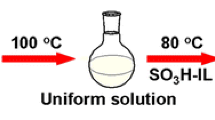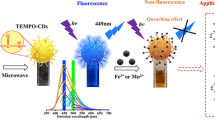Abstract
In this study, carbon dots (CD)-embedded film was successfully fabricated for Fe3+ sensing via a one-pot process. The carbon dots for Fe3+ ion detection were synthesized using the cellulose/ionic liquid solution for different treatment times. With the increase of the treatment time, the N-doped graphitic structure in the core and the functional groups on the surface were highly developed in the carbon dots. The properties and structures of the carbon dots were characterized using TEM, UV–Vis spectroscopy, XPS, IR, TCSPC, and PL spectroscopy. The carbon dots prepared by 12 h treatment showed a high quantum yield of 28.4%, and the superior stability for long-term storage, UV exposure, ionic strength, and pH change. The carbon dots in the film, as well as in the aqueous dispersion, revealed highly selective detection toward Fe3+. The CD-embedded cellulose film can be used as a Fe3+ indicating film with good reusability, outstanding transparency, and high photostability.
Graphic abstract








Similar content being viewed by others
References
Abderrahim B et al (2015) Kinetic thermal degradation of cellulose, polybutylene succinate and a green composite: comparative study. World J Environ Eng 3:95
Ahn Y, Kwak S-Y, Song Y, Kim H (2016a) Physical state of cellulose in BmimCl: dependence of molar mass on viscoelasticity and sol-gel transition. Phys Chem Chem Phys 18:1460–1469
Ahn Y, Song Y, Kwak S-Y, Kim H (2016b) Highly ordered cellulose II crystalline regenerated from cellulose hydrolyzed by 1-butyl-3-methylimidazolium chloride. Carbohydr Polym 137:321–327
Ahn Y, Song Y, Kim H (2017a) In situ formation of autodispersing cellulose nanoparticles with extreme uniformity. ACS Macro Lett 6:762–767
Ahn Y, Song Y, Kim H, Kwak S-Y (2017b) Formation of cellulose-carbene complex via depolymerization in ILs: dependence of IL types on kinetics, conformation and dispersity. Carbohydr Polym 159:86–93
Ahn J et al (2019) Food waste-driven N-doped carbon dots: applications for Fe3+ sensing and cell imaging. Mater Sci Eng C 102:106–112
Arul V, Edison TNJI, Lee YR, Sethuraman MG (2017) Biological and catalytic applications of green synthesized fluorescent N-doped carbon dots using Hylocereus undatus. J Photochem Photobiol B Biol 168:142–148
Barsbay M et al (2007) Verification of controlled grafting of styrene from cellulose via radiation-induced RAFT polymerization. Macromolecules 40:7140–7147
Börjesson M, Westman G (2015) Crystalline nanocellulose-preparation, modification, and properties. In: Poletto M, Ornaghi H Jr (eds) Cellulose-fundamental aspects and current trends. IntechOpen, London, pp 159–191
Chae A et al (2018) Mechanochemical synthesis of fluorescent carbon dots from cellulose powders. Nanotechnology 29:165604
Coates J (2000) Interpretation of infrared spectra, a practical approach. In: Meters RA (ed) Encyclopedia of analytical chemistry. Wiley, Chichester, pp 10815–10837
da Silva Souza DR, Caminhas LD, de Mesquita JP, Pereira FV (2018) Luminescent carbon dots obtained from cellulose. Mater Chem Phys 203:148–155
Du H, Qian X (2011) The effects of acetate anion on cellulose dissolution and reaction in imidazolium ionic liquids. Carbohydr Res 346:1985–1990
Edison TNJI et al (2016) Microwave assisted green synthesis of fluorescent N-doped carbon dots: cytotoxicity and bio-imaging applications. J Photochem Photobiol B Biol 161:154–161
Fang B-Y et al (2018) Nitrogen-doped graphene quantum dot for direct fluorescence detection of Al3+ in aqueous media and living cells. Biosens Bioelectron 100:41–48
Feng Z et al (2017) Nitrogen-doped carbon quantum dots as fluorescent probes for sensitive and selective detection of nitrite. Molecules 22:2061
Gu D, Shang S, Yu Q, Shen J (2016) Green synthesis of nitrogen-doped carbon dots from lotus root for Hg(II) ions detection and cell imaging. Appl Surf Sci 390:38–42
Gu J et al (2018) Green synthesis of amphiphilic carbon dots from organic solvents: application in fluorescent polymer composites and bio-imaging. RSC Adv 8:12556–12561
Guo Y, Zhang L, Cao F, Leng Y (2016) Thermal treatment of hair for the synthesis of sustainable carbon quantum dots and the applications for sensing Hg 2+. Sci Rep 6:35795
He G et al (2017) Microwave formation and photoluminescence mechanisms of multi-states nitrogen doped carbon dots. Appl Surf Sci 422:257–265
Huddleston JG et al (2001) Characterization and comparison of hydrophilic and hydrophobic room temperature ionic liquids incorporating the imidazolium cation. Green Chem 3:156–164
Ishida H et al (2010) Recent advances in instrumentation for absolute emission quantum yield measurements. Coord Chem Rev 254:2449–2458
Jeong Y et al (2018) Converting waste papers to fluorescent carbon dots in the recycling process without loss of ionic liquids and bioimaging applications. ACS Sustain Chem Eng 6:4510–4515
Kang S, Li X, Fan J, Chang J (2012) Characterization of hydrochars produced by hydrothermal carbonization of lignin, cellulose, D-xylose, and wood meal. Ind Eng Chem Res 51:9023–9031
Kim H, Ahn Y, Kwak S-Y (2016) Comparing the influence of acetate and chloride anions on the structure of ionic liquid pretreated lignocellulosic biomass. Biomass Bioenergy 93:243–253
Kim Y, Song Y, Kim H (2018) Preparation of transparent cellulose film with controlled haze using halloysite nanotubes. Cellulose 25:1239–1248
Lee SH, Doherty TV, Linhardt RJ, Dordick JS (2009) Ionic liquid- mediated selective extraction of lignin from wood leading to enhanced enzymatic cellulose hydrolysis. Biotechnol Bioeng 102:1368–1376
Liu Y, Zhou Q (2017) Sensitive pH probe developed with water-soluble fluorescent carbon dots from chocolate by one-step hydrothermal method. Int J Environ Anal Chem 97:1119–1131
Liu S et al (2011) Preparation of photoluminescent carbon nitride dots from CCl4 and 1, 2-ethylenediamine: a heat-treatment-based strategy. J Mater Chem 21:11726–11729
Liu R et al (2015) An ionic liquid promoted microwave-hydrothermal route towards highly photoluminescent carbon dots for sensitive and selective detection of iron (III). RSC Adv 5:24205–24209
Loi E et al (2017) One- pot synthesis of carbon dots using two different acids and their respective unique photoluminescence property. Luminescence 32:114–118
Lu J et al (2009) One-pot synthesis of fluorescent carbon nanoribbons, nanoparticles, and graphene by the exfoliation of graphite in ionic liquids. ACS Nano 3:2367–2375
Ma R et al (2016) Ionic liquid-assisted synthesis of dual-doped graphene as efficient electrocatalysts for oxygen reduction. Carbon 102:58–65
MináKim S et al (2015) In situ synthesis of luminescent carbon nanoparticles toward target bioimaging. Nanoscale 7:5468–5475
Ng YH, Chin SF, Pang SC, Ng SM (2017) The luminescence profile of carbon dots synthesized from α-cellulose under different acid hydrolysis conditions. Opt Mater 70:50–56
Nie H et al (2014) Carbon dots with continuously tunable full-color emission and their application in ratiometric pH sensing. Chem Mater 26:3104–3112
Ogi T et al (2016) Kinetics of nitrogen-doped carbon dot formation via hydrothermal synthesis. New J Chem 40:5555–5561
Ou R et al (2012) Solid biopolymer electrolytes based on all-cellulose composites prepared by partially dissolving cellulosic fibers in the ionic liquid 1-butyl-3-methylimidazolium chloride. J Mater Sci 47:5978–5986
Pels J et al (1995) Evolution of nitrogen functionalities in carbonaceous materials during pyrolysis. Carbon 33:1641–1653
Qu D et al (2014) Formation mechanism and optimization of highly luminescent N-doped graphene quantum dots. Sci Rep 4:5294
Ren J et al (2019) Influence of surface chemistry on optical, chemical and electronic properties of blue luminescent carbon dots. Nanoscale 11:2056–2064
Santiago S et al (2017) Synthesis of N-doped graphene quantum dots by pulsed laser ablation with diethylenetriamine (DETA) and their photoluminescence. Phys Chem Chem Phys 19:22395–22400
Sevilla M, Fuertes AB (2009) The production of carbon materials by hydrothermal carbonization of cellulose. Carbon 47:2281–2289
Shen P, Gao J, Cong J, Liu Z, Li C, Yao J (2016) Synthesis of cellulose- based carbon dots for bioimaging. ChemistrySelect 1:1314–1317
Shi L et al (2016) Controllable synthesis of green and blue fluorescent carbon nanodots for pH and Cu2+ sensing in living cells. Biosens Bioelectron 77:598–602
Shu Y et al (2017) Ionic liquid mediated organophilic carbon dots for drug delivery and bioimaging. Carbon 114:324–333
Silva SS, Mano JF, Reis RL (2017) Ionic liquids in the processing and chemical modification of chitin and chitosan for biomedical applications. Green Chem 19:1208–1220
Song Y et al (2017) Morphological and chemical structure of hydrothermally carbonized saccharides. Fiber Polym 18:1602–1608
Su H, Bi Z, Ni Y, Yan L (2019) One-pot degradation of cellulose into carbon dots and organic acids in its homogeneous aqueous solution. Green Energy Environ 4:391–399
Tan X, Li X, Chen L, Xie F (2016) Solubility of starch and microcrystalline cellulose in 1-ethyl-3-methylimidazolium acetate ionic liquid and solution rheological properties. Phys Chem Chem Phys 18:27584–27593
Tang L et al (2013) Energy-level structure of nitrogen-doped graphene quantum dots. J Mater Chem C 1:4908–4915
Trache D, Hussin MH, Haafiz MM, Thakur VK (2017) Recent progress in cellulose nanocrystals: sources and production. Nanoscale 9:1763–1786
Wang Y et al (2014) Lignin dissolution in dialkylimidazolium-based ionic liquid–water mixtures. Bioresour Technol 170:499–505
Wang S, Chen Z-G, Cole I, Li Q (2015) Structural evolution of graphene quantum dots during thermal decomposition of citric acid and the corresponding photoluminescence. Carbon 82:304–313
Wang C et al (2016) Synthesis of cellulose-derived carbon dots using acidic ionic liquid as a catalyst and its application for detection of Hg 2+. J Mater Sci 51:861–867
Wei L, Li K, Ma Y, Hou X (2012) Dissolving lignocellulosic biomass in a 1-butyl-3-methylimidazolium chloride–water mixture. Ind Crop Prod 37:227–234
Wu R-L et al (2009) Green composite films prepared from cellulose, starch and lignin in room-temperature ionic liquid. Bioresour Technol 100:2569–2574
Wu P et al (2017) Hydrothermal synthesis of nitrogen-doped carbon quantum dots from microcrystalline cellulose for the detection of Fe 3+ ions in an acidic environment. RSC Adv 7:44144–44153
Xiao D et al (2016) One-step hydrothermal synthesis of photoluminescent carbon nitride dots derived from ionic liquids. New J Chem 40:320–324
Xie Y et al (2018) Surface hydrophobic modification of microcrystalline cellulose by poly (methylhydro) siloxane using response surface methodology. Polymers 10:1335
Xu M et al (2013) Hydrothermal/solvothermal synthesis of graphene quantum dots and their biological applications. Nano Biomed Eng 5:65–71
Yang X et al (2014) Novel and green synthesis of high-fluorescent carbon dots originated from honey for sensing and imaging. Biosens Bioelectron 60:292–298
Yang G et al (2016) Acidophilic S-doped carbon quantum dots derived from cellulose fibers and their fluorescence sensing performance for metal ions in an extremely strong acid environment. J Mater Chem A 4:12841–12849
Yang J et al (2017) Hydrothermal synthesis and photoluminescent mechanistic investigation of highly fluorescent nitrogen doped carbon dots from amino acids. Mater Res Bull 89:26–32
Yesudass S et al (2016) Experimental and theoretical studies on some selected ionic liquids with different cations/anions as corrosion inhibitors for mild steel in acidic medium. J Taiwan Inst Chem E 64:252–268
Yu J et al (2018) Luminescence mechanism of carbon dots by tailoring functional groups for sensing Fe3+ ions. Nanomaterials 8:233–244
Zhai X et al (2012) Highly luminescent carbon nanodots by microwave-assisted pyrolysis. Chem Commun 48:7955–7957
Zhang P et al (2014) Updating biomass into functional carbon material in ionothermal manner. ACS Appl Mater Interfaces 6:12515–12522
Zhang B et al (2015) Understanding the structural disorganization of starch in water–ionic liquid solutions. Phys Chem Chem Phys 17:13860–13871
Zhang Y et al (2016) Effect of reaction temperature on structure and fluorescence properties of nitrogen-doped carbon dots. Appl Surf Sci 387:1236–1246
Zheng B et al (2015) One pot selective synthesis of water and organic soluble carbon dots with green fluorescence emission. RSC Adv 5:11667–11675
Zu F et al (2017) The quenching of the fluorescence of carbon dots: a review on mechanisms and applications. Microchim Acta 184:1899–1914
Acknowledgments
This research was supported by the National Research Foundation of Korea (NRF) funded by the Ministry of Science (NRF-2018R1A2B6003570).
Author information
Authors and Affiliations
Corresponding author
Additional information
Publisher's Note
Springer Nature remains neutral with regard to jurisdictional claims in published maps and institutional affiliations.
Electronic supplementary material
Below is the link to the electronic supplementary material.
Rights and permissions
About this article
Cite this article
Woo, J., Song, Y., Ahn, J. et al. Green one-pot preparation of carbon dots (CD)-embedded cellulose transparent film for Fe3+ indicator using ionic liquid. Cellulose 27, 4609–4621 (2020). https://doi.org/10.1007/s10570-020-03099-5
Received:
Accepted:
Published:
Issue Date:
DOI: https://doi.org/10.1007/s10570-020-03099-5




